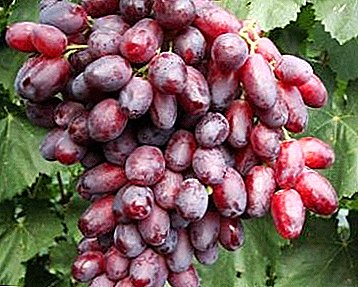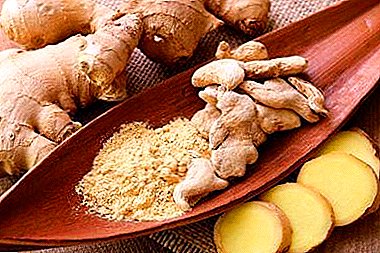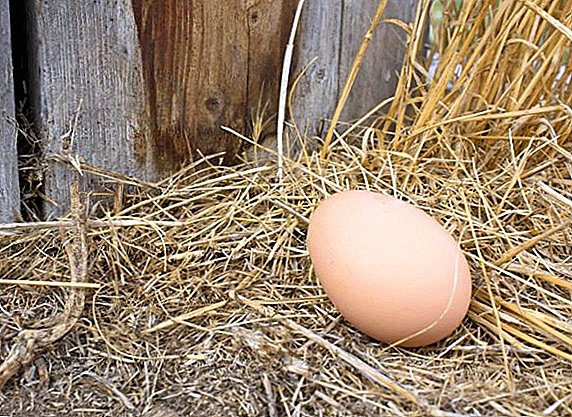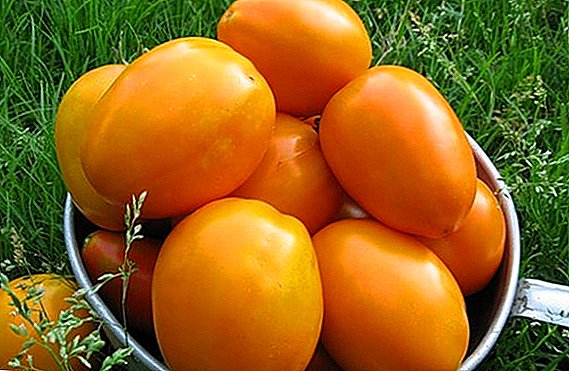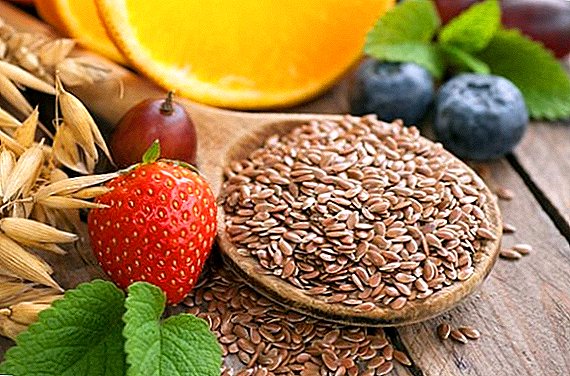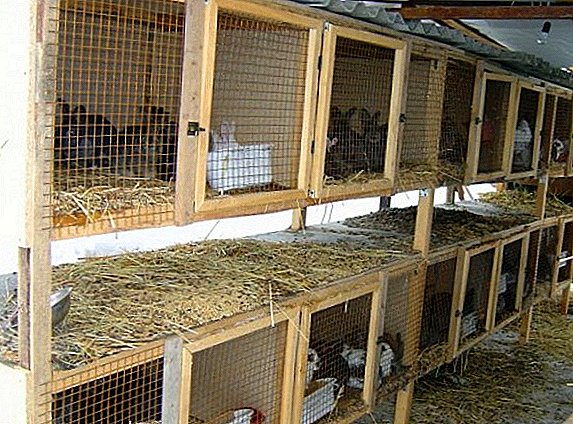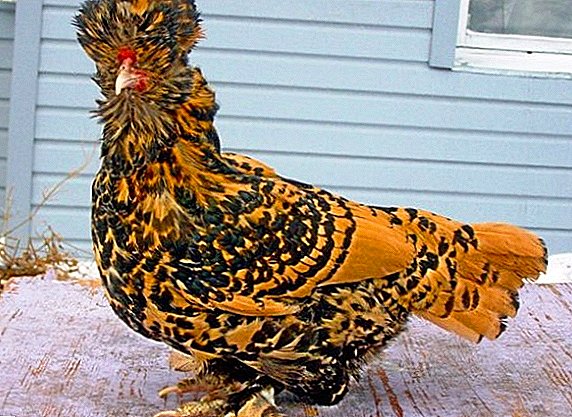 The hen in our mind is a not very smart, fussy and not too neat bird, in which there is no grace and refinement. Few people know that, in fact, among these birds, there are true beauties who are not inferior in decoration to pheasants and peacocks (by the way, also to representatives of a large group of chicken-like). So, we get acquainted: Pavlovsky chickens.
The hen in our mind is a not very smart, fussy and not too neat bird, in which there is no grace and refinement. Few people know that, in fact, among these birds, there are true beauties who are not inferior in decoration to pheasants and peacocks (by the way, also to representatives of a large group of chicken-like). So, we get acquainted: Pavlovsky chickens.
Description and features of the breed
First of all, it should be said that we are talking about an ornamental bird, which is bred not so much for meat and eggs, as for simply admiring its bright appearance. It turns out that it happens!
History of origin
Pavlovsk chickens - The oldest Russian breed. Despite the fact that its first official description dates back to the end of the nineteenth century, it appeared in Russia many centuries earlier. Unfortunately, no breeding journals were conducted in those days, so it is already impossible to establish for sure how this beautiful bird was bred.  There is a version that Persian relatives who could be brought to Russia by Greek merchants participated in the selection of these chickens. Only one thing is known for certain: in 1905, when in Russia almost for the first time they started describing national breeds of poultry, and the Pavlovian breed gained full status, it was already so rare that there was a real risk of losing it completely, about which written complaints of contemporaries remained .
There is a version that Persian relatives who could be brought to Russia by Greek merchants participated in the selection of these chickens. Only one thing is known for certain: in 1905, when in Russia almost for the first time they started describing national breeds of poultry, and the Pavlovian breed gained full status, it was already so rare that there was a real risk of losing it completely, about which written complaints of contemporaries remained .
Learn about the nuances of breeding other breeds of chickens: Brama, Kuchinsky Jubilee, Kokhinkhin, Poltava, Leggorn, Adler, Russian White, Rhode Island, Minorca, Zagorskaya salmon, Orpington, Maran, Fireol, Amrox, Sussex.
The breed owes its name to the village of Pavlovo in Nizhny Novgorod (now it is a city with the same name). Long since this place was famous for its craft. By the highest command of Her Majesty Catherine the Great, the local serfs were allowed to freely move around the endless expanses of Russia and even to go beyond its borders in order to sell their products.  It is possible that from such travels people, in addition to money, brought various goods, including strange plants and animals, which they then successfully bred in their homeland.
It is possible that from such travels people, in addition to money, brought various goods, including strange plants and animals, which they then successfully bred in their homeland.
Thus, the ancestors of Pavlovian chickens could get into a Nizhny Novgorod place from the southern countries (Persia, Bukhara, Ottoman Empire), with which local artisans were active in trade. However, the opposite option is not excluded: beautiful birds raised in Pavlovo were acquired for the Turkish monarch, who then, in 1854, sold their descendants to England under the name "Sultan".
There is no doubt that Pavlovsky chickens in one way or another were bred in Russia, and according to all the rules of genetics - by crossing individuals with recessive traits, which, of course, our ancestors did not know anything, but intuitively acted almost unmistakably . It is known for certain that at least in the second half of the 18th century this breed was already fully formed, and after its “legalization” it became a permanent favorite of both national and international exhibitions.  Alas, the twentieth century has become fatal for the breed. In the country built by the Bolsheviks, there was no place for private agriculture, nor for poultry bred "for beauty." Together with the destroyed kulaks, the decorative bird, which had rejoiced the human eye for centuries, also perished. Only in the time of Gorbachev's “perestroika”, the attitude towards individual farming changed, however, the old Pavlovian breed was considered irretrievably lost by that time.
Alas, the twentieth century has become fatal for the breed. In the country built by the Bolsheviks, there was no place for private agriculture, nor for poultry bred "for beauty." Together with the destroyed kulaks, the decorative bird, which had rejoiced the human eye for centuries, also perished. Only in the time of Gorbachev's “perestroika”, the attitude towards individual farming changed, however, the old Pavlovian breed was considered irretrievably lost by that time.
Today's Pavlovsky chickens are the result of the painstaking work of breeders aimed at restoring an amazing breed according to descriptions taken from official sources of the early twentieth century (in particular, the monographs of Ivan Ivanovich Abozin, who had been engaged in food industry, and Alexander Sergeevich Serebrovsky, the famous Russian and Soviet geneticist books "Poultry Genetics").
External differences
The main decorative qualities of Pavlovsky chickens are associated primarily with the plumage, which is their business card - this is a motley pattern in the form of numerous black spots on a golden or silver background. At the base and at the end of the feathers are black, in the middle - the main shade.  Interestingly, the hens of this breed are not inferior in beauty to the plumage of males (although usually the representatives of this family have the "weaker sex" look rather inconspicuous, mostly roosters adorn).
Interestingly, the hens of this breed are not inferior in beauty to the plumage of males (although usually the representatives of this family have the "weaker sex" look rather inconspicuous, mostly roosters adorn).
Also, the breed is distinguished by a crest, which resembles a helmet or even a wide, sometimes sprawling crown, the feathers of which are directed upwards without disturbing the view, as well as large beards and tanks, consisting of slightly bristling feathers, descending from the very eyes.
Pavlov's birds do not belong to large and heavy ones, on the contrary, they look very graceful. The body is compact, like an egg-laying hen, but more concise, almost horizontal; the back is medium, from the side of the tail is narrower, the chest protrudes slightly forward. The neck is not long, slightly curved, covered over the entire length with a very lush boa, looking like a lion's mane.
The head is small, slightly rounded. The eyes are rather large and slightly protruding, the color may be yellow, cherry-black or very dark.  Yellow, pink or blue-black beak is thin, not long, can be straight or slightly curved. The nostrils are clearly visible, rising above the beak in the form of a box (this is especially clearly seen in profile). Earlobes and earrings, on the contrary, are almost invisible in thick plumage. A small comb in an underdeveloped state is located across the head of the bird just above the beak, behind it is a chic tuft.
Yellow, pink or blue-black beak is thin, not long, can be straight or slightly curved. The nostrils are clearly visible, rising above the beak in the form of a box (this is especially clearly seen in profile). Earlobes and earrings, on the contrary, are almost invisible in thick plumage. A small comb in an underdeveloped state is located across the head of the bird just above the beak, behind it is a chic tuft.
The tail of the birds is very big and lush, like a fan, with the end of the back is an angle of 45 degrees. Feathers in this part are very long and thick, beautifully curving at the ends downwards.
The wings are powerful, with feathers reaching to the tail. If the bird is calm, the wings are tightly pressed to the body.
The legs are strongly supported from all sides, including even the toes, this is another breed card. The shins are short, covered with long curved feathers upwards, similar to spurs (in poultry breeders this is called “hawk knee pads”). The paws themselves are dark, sometimes almost black. 
Productive qualities
As already mentioned, breed selection was aimed primarily at the preservation and development of decorative qualities, therefore, no one set quality and quantity of meat, as well as egg production. However, this does not mean at all that this bird can be blamed for unproductiveness, simply because of this quality it cannot withstand competition either from purely meat or egg breeds.
So, poultry hens egg production is 150-160 eggs per yearthat is considered quite a high figure, although for a breed that is bred as an egg, this is not the result.
Did you know? The world record of egg production is considered to be 371 eggs for 364 days; it was established in the state of Missouri, USA, in 1979. We are obliged to such a result to a layer of white leggorn. A representative of the same breed half a century earlier, in 364 days, laid down only ten eggs less. This breed became famous for the record weight of the egg - it was 454 grams (although this egg had two shells and two yolks, that is, in fact, it was two fused eggs).Of course, Pavlovian chickens have eggs that are much smaller: on average, they weigh about 50 g and have a rather dense white or light cream shell. The weight of an adult chicken is just over one and a half kilograms, the males weigh an average of half a kilo more.
With regard to the quality of meat, it should be said that those few gourmets who had the occasion to try Pavlovian chicken tasted, claim that it resembles game rather than poultry. At the same time, the meat is exceptionally tender and smells delicious. It is also commonly accepted that such chicken meat practically does not cause allergies (by the way, this feature applies to eggs of this breed). There are even cases when people who have a pronounced allergic reaction to eggs or chicken meat have discovered the world, starting to eat products from the Pavlovian breed.
However, cooking soup from Pavlovian chicken is the same as hammering nails with an expensive microscope. This breed is bred for other purposes, valued due to other qualities and, by the way, is quite beneficial in growing, because it is in high demand among connoisseurs.
Did you know? It is known that at an auction in Italy a pair of Pavlovian feathered animals went under the hammer for two and a half million dollars! It was true, in 1988, when, as we have already mentioned, the breed was so rare that it was considered practically irretrievably lost.But even today, breeding Pavlovian chickens offers the owner quite good profits and, moreover, is a very prestigious business, since the breed is extremely popular, and not a single internationally respected international exhibition ignores it.
Temperament
It's safe to say that Pavlovian chicken is a bird with character. Moreover, if the females and the males are not inferior to each other in beauty, their temper is completely different.  "Girls" are true phlegmas. It seems that nothing can bring them out of balance. Calm at them borders on awkwardness, degree - with retardation. These chickens are quite difficult to rehash, however, perhaps this is because they feel "like a stone wall", because the representatives of the "strong half" of this breed have a completely opposite character.
"Girls" are true phlegmas. It seems that nothing can bring them out of balance. Calm at them borders on awkwardness, degree - with retardation. These chickens are quite difficult to rehash, however, perhaps this is because they feel "like a stone wall", because the representatives of the "strong half" of this breed have a completely opposite character.
Concluding the conversation about the chickens, let us say that they, due to their phlegmatic nature, are excellent chickens, very attentive and caring babies to their offspring. Poultry farmers say the minimum mortality rate among chickens of this breed (no more than 10%). By pavlovsky laying hens, farmers often lay eggs of less caring “cuckoos” chickens, and these quivering mothers are watching the alien offspring no less carefully than their own.  But the roosters from Pavlova are mere robbers! The struggle for leadership among them is a common thing, and having won the championship, the leader does not calm down until he completely demoralizes (if not to say, physically eliminates) competitors. So cockfighting in the house is a normal practice, which, unfortunately, should be considered a beginning breeder.
But the roosters from Pavlova are mere robbers! The struggle for leadership among them is a common thing, and having won the championship, the leader does not calm down until he completely demoralizes (if not to say, physically eliminates) competitors. So cockfighting in the house is a normal practice, which, unfortunately, should be considered a beginning breeder.
Varieties
There are several varieties of Pavlovian breed of chickens, which differ from each other mainly in the color of their plumage (and, perhaps, in the form of a tuft). In particular, silver, golden (or black and golden), black and white, fawn and white colors are distinguished; however, the first two of the above are the most famous.
Silvery
In the silvery, or, as it is also called, silvery-spotted variety, the main color of the main tail is silvery-white. As mentioned in the description of the breed standard, the lower and upper parts of each feather are black, which creates the impression of variegation, but the spots have the correct shape. In the same dark color painted beard and bird tanks.  Fly feathers differ in color from the outer (black) and inner (silver) sides. On the tail and tail feathers there are also corresponding spots.
Fly feathers differ in color from the outer (black) and inner (silver) sides. On the tail and tail feathers there are also corresponding spots.
If you look at the front part of the bird, you can clearly see that the beautiful shiny black parts of each feather on the tuft, neck, shoulders, back and belt are formed into a kind of "tick" or letter "V" of the Latin alphabet. 
Golden
All that has been described above with respect to the silver-spotted variety fully relates to the golden one, with the only difference being that in this case the basic color of the feather is not silver-white, but golden-brown. 
How not to make a mistake when buying
Since the Pavlovian breed is quite valuable, it is very important when acquiring such chickens not to fall for the bait of unscrupulous distributors and get really valuable breeding material.
Of course, it is necessary to carefully and consistently inspect the "live product" for its full compliance with the stated characteristics.
Important! A novice breeder should first know the signs that mean an unequivocal disqualification of Pavlovian chicken, which precludes its use in breeding.Inadmissible defects include:
- fifth toe;
- no beard;
- disproportionate beard (too big or too small);
- leg color other than dark;
- too much feathered legs;
- lack of feathering or bare spots on the legs or feet;
- falling down, falling apart, too loose or, on the contrary, too hard tuft;
- the presence of extraneous color in the plumage.
However, since we are talking about an elite bird, rather than ordinary layers, it is advisable to seek help from a specialist who can help you with a choice, or purchase goods only from trusted suppliers.  Interestingly, recently, special websites have appeared on the Web in an attempt to create a kind of database of owners of a particular breed of poultry. There is such a base for Pavlovian chickens. Perhaps the presence of information about the breeder on this site and is not an absolute guarantee that you will not be deceived, but still you will have certain confidence when buying.
Interestingly, recently, special websites have appeared on the Web in an attempt to create a kind of database of owners of a particular breed of poultry. There is such a base for Pavlovian chickens. Perhaps the presence of information about the breeder on this site and is not an absolute guarantee that you will not be deceived, but still you will have certain confidence when buying.
In addition to a visual statement of compliance with the breed, of course, you should make sure that the chicken is healthy. Usually it is easy to determine by the appearance and behavior of the bird, but it is imperative that you require a veterinary certificate from the seller.
Conditions of detention
Since these birds were originally bred not for meat or eggs, but rather for admiring them, keeping and breeding them implies serious differences compared to the usual house for us.
Important! Pavlovsky chickens practically do not tolerate life in a cage!Spacious rooms are necessary for keeping these birds and - necessarily! - the possibility of free walking in the fresh air every day (even the fallen snow is not a reason to limit the walks of this breed bred in the northern latitudes).
 Failure to follow these rules inevitably leads to the fact that the active bird in nature begins to ache and languish, while with proper care it is distinguished by excellent immunity and high resistance to colds and infectious diseases. In addition, a tight chicken coop provokes conflicts with already temperamental cockerels, who begin to fight not only for primacy, but literally for every centimeter of area.
Failure to follow these rules inevitably leads to the fact that the active bird in nature begins to ache and languish, while with proper care it is distinguished by excellent immunity and high resistance to colds and infectious diseases. In addition, a tight chicken coop provokes conflicts with already temperamental cockerels, who begin to fight not only for primacy, but literally for every centimeter of area.The nature of the breed must also be taken into account when arranging drinking bowls and feeders - each individual must have free access to feed and water.
Equip roosts in such a way that no more than three layers are placed on one meter.  Actually, this is all that Pavlovsky breed differs from its relatives. Cleanliness, warmth, timely vaccination and adherence to safety measures are necessary in any poultry house, and our heroes are, of course, no exception.
Actually, this is all that Pavlovsky breed differs from its relatives. Cleanliness, warmth, timely vaccination and adherence to safety measures are necessary in any poultry house, and our heroes are, of course, no exception.
What to feed
But feeding is much easier. Any food used by kurovodami, it is suitable for representatives of the Pavlovsk breed. Moreover, since these birds will spend most of their time every day on free grazing, they will perfectly provide themselves with the necessary protein component and other elements that are important for normal development at the expense of independently obtained food — all kinds of insects, worms and bugs, as well as berries and other delicacies. .
Important! Excessive enthusiasm for dry feed in favor of cleanliness in the house - not quite a good option. The fact is that it is moist food that is best absorbed by chicken and is the main source of available proteins, fats and carbohydrates. For this purpose, it is better to form the ration of your pets due to the so-called mixers - a mix of chopped vegetables, grains, oilcake, mixed feed, various additives and liquids (water or yogurt).You can use various cereals from dry feeds, changing them periodically so that the nutrition is balanced, or, if possible, ready-made combined feeds.
 In the warm season, it’s enough to feed the birds twice a day, but in winter, when getting pasture becomes impossible, you need to add one more meal per day. In addition, at this time it is necessary to focus on vitamins that the bird can not get from other sources and that will strengthen its immunity and protect it from the cold.
In the warm season, it’s enough to feed the birds twice a day, but in winter, when getting pasture becomes impossible, you need to add one more meal per day. In addition, at this time it is necessary to focus on vitamins that the bird can not get from other sources and that will strengthen its immunity and protect it from the cold.How to endure winter
Pavlovskaya chicken belongs to frost-resistant breeds, and there is no doubt left, if you look at its fluffy plumage. Thus, if in the room allocated for keeping poultry the temperature in winter will not fall below 10 degrees Celsius, nothing more is needed.  The mobility and activity of the chickens will provide them with additional protection from the cold.As already mentioned, in the winter you should not limit your wards in walks in the fresh air, except in very cold weather, when they can damage their scallops.
The mobility and activity of the chickens will provide them with additional protection from the cold.As already mentioned, in the winter you should not limit your wards in walks in the fresh air, except in very cold weather, when they can damage their scallops.
Important! An important condition for preparing the house for winter is a dense blockage of cracks, because drafts, unlike frost, are extremely harmful to birds (however, not only in winter). During this period it is better to lay the litter not of pure hay, but in a mixture with peat - it will provide additional heat.
Rearing
Of course, the rearing of chickens has certain peculiarities in comparison with adult poultry.
Maintenance and care
Pavlovian chickens begin to be born early enough. The first clutch can be observed in birds that have barely reached five months, and literally within a few weeks the process becomes stable and stable. Such dates, of course, do honor to the breed, because the future income of the farmer also depends on when the hen starts laying eggs. 
Did you know? On average, egg breeds of chickens start laying eggs about a month earlier than meat ones - Pavlovian breed is approximately halfway between these two groups according to this indicator.As was said, the hens from our chickens are excellent, but artificial laying of eggs is also quite possible. In the first days of life, it is important for chickens to provide heat, so if we are talking about an incubator, additional heating will be needed.
Nestlings from the laid eggs appear approximately on the 21st day. At first, they are quite tiny, and instead of feathers their body is covered with soft down, but quite quickly the real plumage begins to form, so the kids will not need heating anymore soon.  In newborn chickens, sex cannot be as easily determined as in adult birds. An indicator of the fact that in front of you is a cockerel, can be considered larger paws. As they grow up, chickens, as a rule, get overgrown with feathers earlier than cockerels.
In newborn chickens, sex cannot be as easily determined as in adult birds. An indicator of the fact that in front of you is a cockerel, can be considered larger paws. As they grow up, chickens, as a rule, get overgrown with feathers earlier than cockerels.
Did you know? The Japanese almost unmistakably determine the sex of the crumbs according to the structure of the genital tubercle, but it is located near the bird inside the cloaca, which you must first open, firmly grasping the chick and holding it upside down. We would not recommend using this method to beginners, because at first such training can cost health and even the lives of many babies who have appeared in your poultry house.The first days of a chick's life are a guarantee of their survival and subsequent health. During this period, they do not need space, much more important is a constant temperature in the range of 28 to 32 degrees Celsius, dryness (air humidity should not exceed 65%, but it is undesirable to fall below 55%) and, of course, cleanliness.

Important! Chicks too dry air will forgive the owner, but excess moisture is a source of infection and even loss of chicks.However, if the kids are not divorced from the attentive mother, she will take on part of the task of creating optimal conditions for herself, the breeder will need only the most elementary - regular replacement of bedding, clean dishes, high-quality food.
Timely vaccination is also an integral part of the care of the young.
Feeding
In the first days of life, the chickens feed should consist of finely chopped greens, cottage cheese, small cereals (manna, corn) and, however terrible it may sound, boiled chicken eggs mashed in mashed potatoes. A day later, vitamins and other specialized supplements for chickens are added to food.
However, by the middle of the second week of life, small birds can be gradually transferred to adult feed, not forgetting to pamper them regularly with fresh greens and vegetables.  Summing up, it should be said that the chickens are quite capricious in the care of the creature. The saying “chickens until the fall is considered” means that the initially excellent result is by no means always preserved in the end, speaks in this sense for itself. Pavlovsky chickens, we will not dissemble, are no exception.
Summing up, it should be said that the chickens are quite capricious in the care of the creature. The saying “chickens until the fall is considered” means that the initially excellent result is by no means always preserved in the end, speaks in this sense for itself. Pavlovsky chickens, we will not dissemble, are no exception.
But the attentive owner will be rewarded with incredible beauty of feathering, in which this breed can compete with exotic relatives such as pheasants, and the added bonus will be the prestige and rarity of Pavlovian chickens, and, consequently, the rather convincing price of them, as well as the obvious patriotism of such a business, because Pavlovian chickens are the most Russian chickens in the world!


